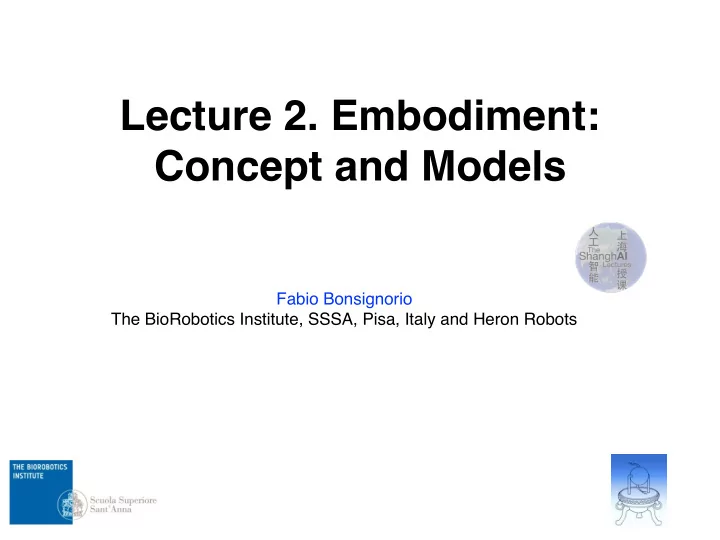

Lecture 2. Embodiment: Concept and Models Fabio Bonsignorio The BioRobotics Institute, SSSA, Pisa, Italy and Heron Robots
Intelligence : Hard to agree on definitions, arguments necessary and sufficient conditions? • are robots, ants, humans intelligent? • more productive question: “Given a behavior of interest, how to implement it?” 2
Successes and failures of the classical approach successes failures applications (e.g. foundations of Google) behavior chess natural forms of intelligence manufacturing interaction with real (“controlled”artificial world worlds) 3
The “symbol grounding” problem real world: doesn’t come with labels … How to put the labels?? Gary Larson 4
Two views of intelligence classical: cognition as computation embodiment: cognition emergent from sensory- motor and interaction processes 5
The need for an embodied perspective “failures” of classical AI • fundamental problems of classical approach • Wolpert’s quote: Why do plants not …? • (but…check…Barbara Mazzolai’s lecture…) Interaction with environment: always • mediated by body 6
“Frame-of-reference” Simon’s ant on the beach simple behavioral rules • complexity in interaction, • not — necessarily — in brain thought experiment: • increase body by factor of 1000 7
Industrial robots vs. natural systems principles: humans - low precision - compliant - reactive - coping with uncertainty robots no direct transfer of methods 8
Communication through interaction with exploitation of interaction with environment • simpler neural circuits angle sensors in joints “parallel, loosely coupled processes” 9
Emergence of behavior: the actuated: quadruped “Puppy” oscillation simple control (oscillations of • springs “hip” joints) spring-like material properties • (“under-actuated” system) passive self-stabilization, no sensors • “outsourcing” of functionality • morphological computation 10
Implications of embodiment “Puppy”, But Also Cruse Pfeifer et al.,Science, 16 Nov. 2007 11
Implications of embodiment “Puppy” which part of diagram is relevant? —> Pfeifer et al.,Science, 16 Nov. 2007 12
Recommend
More recommend